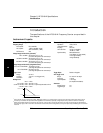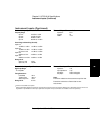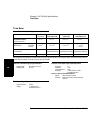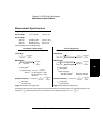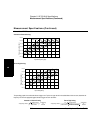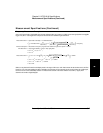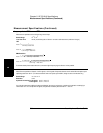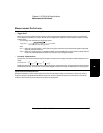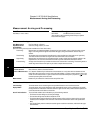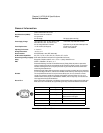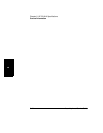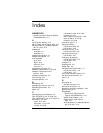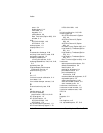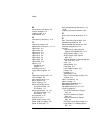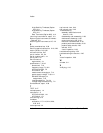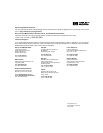
Chapter 8 HP 53181A Specifications
Measurement Arming and Processing
8-10 Assembly-Level Service Guide
8
Measurement Arming and Processing
Gate Time
Auto Mode, or 1 ms to 1000 s
Measurement Throughput
HP-IB ASCII: 200 Measurements/s (maximum)
(See examples in the Programming Guide for ways to optimize
measurement throughput)
Measurement Arming
Start Measurement: Free Run, Manual, or External
Stop Measurement: Continuous, Single, External, or Timed
Arming Modes:
(Note: auto arming is the only mode available for the Peak Volts function.)
Auto Arming: Measurements are initiated immediately and acquired as fast as possible, using a minimum number of signal
edges. Auto arming offers the highest measurement throughput, though measurement resolution may be
reduced.
Timed Arming: The duration of the measurement is internally timed to a user-specified value (also known as the “gate time”).
This mode should be used when the length of the measurement time must be controlled.
Digits Arming: Measurements are performed to the requested resolution (number of digits) through automatic selection of the
acquisition time. This is the most convenient mode when a specific measurement resolution is desired.
External Arming: An edge on the External Arm Input enables the start of each measurement. Auto Arming, Timed arming modes or
another edge on the External Arm Input may be used to complete the measurement.
Measurement Statistics
Available Statistics: Mean, Minimum, Maximum, Standard Deviation
Number of Measurements: 2 to 1,000,000. Statistics may be collected on all measurements or on only those which are between the limit
bands. When the Limits function is used in conjunction with Statistics, N (number of measurements) refers to the
number of in-limit measurements. In general, measurement resolution will improve in proportion to , up to the
numerical processing limits of the instrument.
Measurements: Statistics may be collected for all measurements except Peak Volts.
Measurement Limits
Limit Checking: The measurement value is checked against user-specified limits at the end of each measurement.
Display Modes: The measurement result may be displayed as either the traditional numeric value or graphically as an asterisk
moving between two vertical bars. These bars define the upper and lower limits, and the asterisk represents the
current measurement result relative to these limits.
Out-of-Limits Indication: The out-of-limits condition can be indicated by any of the following methods:
• The limits annunciator will light on the front panel display.
• The instrument will generate an SRQ if enabled via HP-IB.
• The limits hardware signal provided via the RS-232 connector will go low for the duration of the out-of-limit
condition (see the description of this connector under the General Information section of this specifications
table).
• If the Analog Display mode is enabled, the asterisk appears outside the vertical bars, which define the upper
and lower limits.
N



